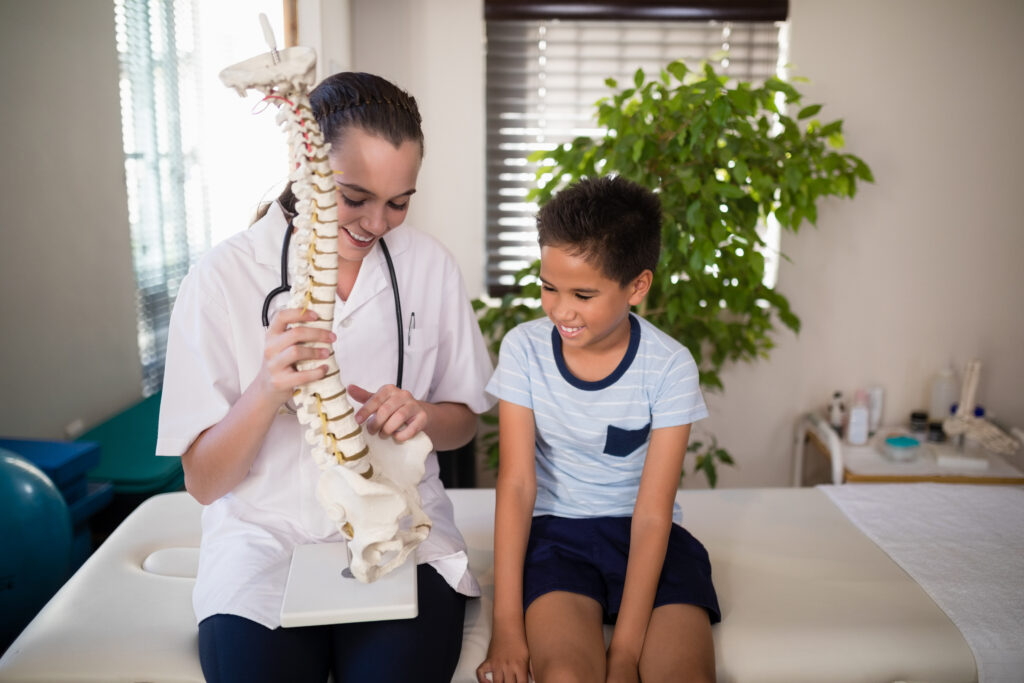Scoliosis is a medical condition that affects the curvature of the spine, and its severity and impact can vary depending on when it first manifests. Juvenile scoliosis, in particular, poses unique challenges due to its onset during a critical period of growth and development. Dr. Strauss explains what juvenile scoliosis is, its dangers, and the importance of early detection and intervention.
Understanding Juvenile Scoliosis
Scoliosis is commonly divided based on the age of onset, and juvenile scoliosis falls into the category where symptoms first appear between the ages of 3 and 10 years old. This makes it distinct from other forms of scoliosis, such as adolescent or adult-onset scoliosis. Juvenile scoliosis is particularly concerning because it emerges during a phase of rapid growth in a child’s life.
The Critical Age Range: 3 to 10 Years Old
The age range for juvenile scoliosis, from 3 to 10 years old, is significant because it coincides with a period of intense growth. Children experience remarkable growth spurts during these years, with the most rapid occurring around the age of 10. During this time, a child can grow up to four inches in a single year. It is precisely during these growth spurts that juvenile scoliosis can become especially problematic.
Rapid Progression: A Cause for Concern
One of the key dangers associated with juvenile scoliosis is its potential for rapid progression. Unlike some forms of scoliosis that may develop more gradually, juvenile scoliosis can advance swiftly, especially during periods of accelerated growth. This rapid progression can lead to the development of large spinal curves if left untreated.
The Significance of Early Detection
Early detection is crucial when it comes to juvenile scoliosis. Identifying the condition during the early stages, ideally before the age of 6 or 7, provides a window of opportunity for effective intervention. Without timely detection and intervention, children with juvenile scoliosis may face an increased risk of developing severe spinal deformities.
Challenges in Treating Younger Children
Treating juvenile scoliosis presents unique challenges, mainly because young children may not be able to participate in certain treatment modalities effectively. For instance, exercises that are commonly used in scoliosis management may require a level of understanding and compliance that younger children may find difficult to achieve.
Age-Appropriate Treatment Strategies
To effectively address juvenile scoliosis, healthcare professionals often have to tailor their treatment strategies to be age-appropriate. While exercises play a crucial role in managing scoliosis, younger children may need modified or specialized exercises that accommodate their developmental stage and capabilities. Additionally, bracing may be considered as part of the treatment plan to help control the progression of the spinal curvature.
The Role of Bracing in Juvenile Scoliosis
Bracing is a common intervention for scoliosis, including juvenile cases. The purpose of bracing is to provide external support to the spine, helping to prevent further progression of the curvature. In juvenile scoliosis cases, bracing is often recommended when the child reaches an age where they can effectively wear and benefit from the brace. The duration and type of brace prescribed will depend on the severity and progression of the scoliosis.
The Importance of Regular Monitoring
Given the dynamic nature of juvenile scoliosis, regular monitoring is essential. This involves periodic check-ups and imaging to assess the progression of the curvature. Monitoring allows healthcare professionals to make necessary adjustments to the treatment plan based on the child’s growth and the evolving nature of the scoliosis.
Collaboration between Healthcare Providers and Parents
The successful management of juvenile scoliosis requires a collaborative effort between healthcare providers and parents. Educating parents about the condition, treatment options, and the importance of compliance with prescribed interventions is crucial. Open communication ensures that parents are well-informed partners in the journey to manage their child’s scoliosis effectively.
Conclusion: Navigating the Challenges of Juvenile Scoliosis
In conclusion, juvenile scoliosis poses a unique set of challenges due to its onset during the critical age range of 3 to 10 years old. The rapid progression of the condition during periods of accelerated growth underscores the importance of early detection and intervention. Healthcare professionals play a vital role in tailoring age-appropriate treatment strategies, which may include exercises, bracing, and regular monitoring. Collaboration between healthcare providers and parents is key to ensuring the successful management of juvenile scoliosis, ultimately promoting the optimal spinal health and well-being of affected children.
Also read: Why do You Have to Treat Scoliosis at a Young Age?
About:
Dr. Strauss is the director of the Hudson Valley Scoliosis Correction Center in New York. He has been actively engaged in scoliosis treatment for the past 30 years and has authored two books on the subject, Your Child Has Scoliosis and The Truth About Adult Scoliosis.
He is Vice President of the CLEAR Scoliosis Institute and a lecturer for their introductory and advanced workshops. He is certified in scoliosis bracing and in the use of scoliosis specific exercises. Dr. Strauss is a graduate of the ISICO World Masters of Scoliosis.His postgraduate studies also include a Masters Degree in Acupuncture as well as training in Grostic, Pettibon, CBP, Clinical Nutrition, Chinese Herbal Medicine, Manipulation under Anesthesia, and Electrodiagnosis.
His scoliosis practice has treated patients from 25 states and 32 other foreign countries.If you have questions about childhood and adult scoliosis and how it can be successfully treated without surgery subscribe to our channel!
